Coronavirus Today: A different vaccine calculus for younger kids
Good evening. I’m Karen Kaplan, and it’s Friday, Oct. 29. Here’s the latest on what’s happening with the coronavirus in California and beyond.
For nearly a year, there has been one overarching message when it comes to COVID-19 vaccines: If you are eligible to get one, you should. Not only will the vaccines protect you, but they’ll also protect those around you by depriving the coronavirus of a body to infect. The sooner we all get vaccinated, the sooner transmission will slow enough to bring the pandemic to an end.
So it was a little jarring to hear some members of the Food and Drug Administration’s advisory committee on vaccines say they were hesitant about recommending that Pfizer and BioNTech’s lower-dose vaccine be authorized for younger children because they feared the kids would be coerced into getting the shots.
Dr. Michael Nelson, a University of Virginia immunologist, was one of the 17 committee members who voted in favor of encouraging the FDA to give the kid-friendly vaccine a green light. (None of the advisors voted against it, and one abstained.) But Nelson also stressed that, although the vote was unanimous, it was “not a mandate” to inoculate all of the nation’s 28 million children ages 5 to 11.
Dr. Arnold Monto, a University of Michigan epidemiologist, said he voted yes despite his “reservations” over “how groups we have no control over will act” if the FDA followed their advice and authorized the vaccine, as it did today.
For instance, Monto and others worried that some school districts would implement vaccine mandates for younger children once the shots became available.
That wouldn’t be a total surprise considering the enthusiasm for the shots emanating from the White House and some state capitals. Last week, before FDA scientists or their independent advisors had even assessed the Pfizer data, the Biden administration touted its plans to make sure the vaccine would be available at pediatricians’ offices, pharmacies and schools across the country.
“We’re going to be ready,” White House COVID-19 coordinator Jeff Zients promised.
Likewise, California health officials are already preparing to make roughly 3.5 million doses of the Pfizer vaccine available to young children by the end of next week.
“The more vaccinations we get into the arms of eligible Californians, the more we stop the spread and shrink the pool of people vulnerable to COVID-19,” said state epidemiologist Dr. Erica Pan. “Our youngest children have remained vulnerable to the highly contagious virus as older Californians have received their vaccine. Now the time is coming to protect them.”
Why does that kind of talk worry the FDA advisors?
Their job is to assess whether the benefits of a vaccine outweigh the risks. For this age group — which has suffered fewer than 100 documented COVID-19 deaths over the course of the pandemic — the benefits are uncertain, and the risks are unknown.
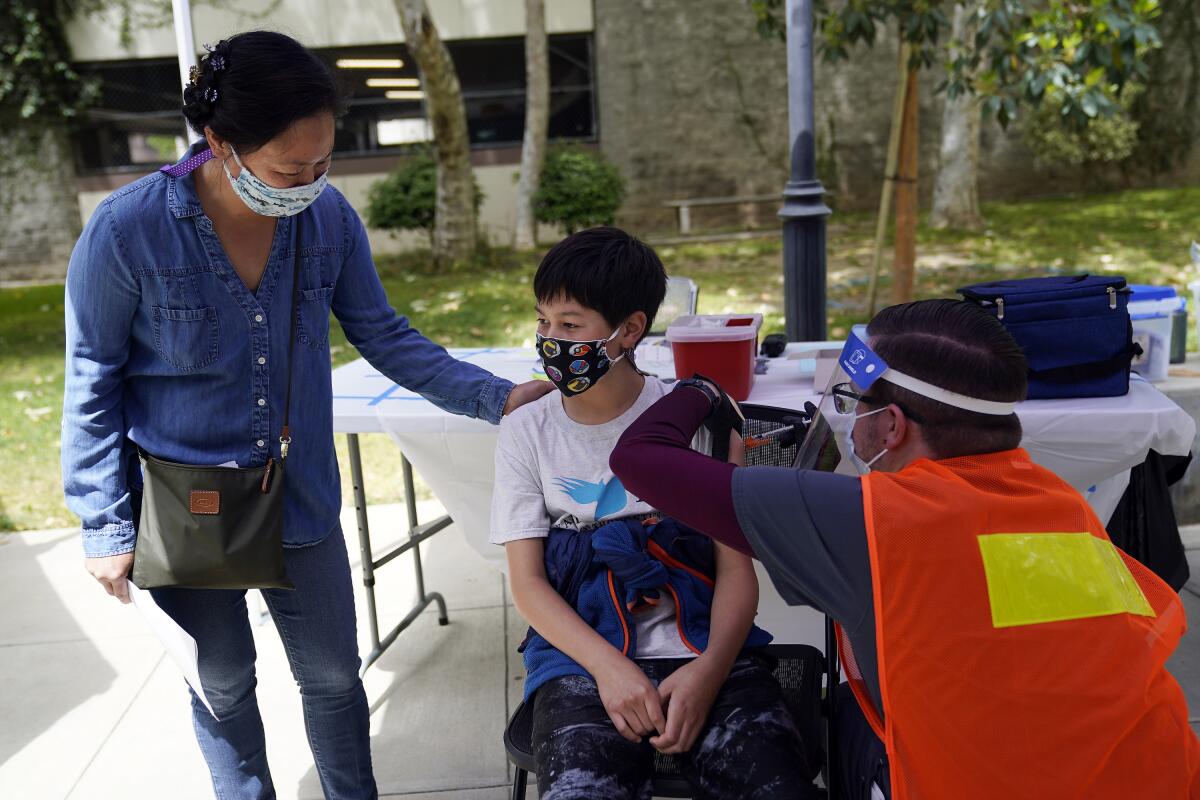
The primary risk on their minds was the chance the vaccine would cause myocarditis, an inflammation of the heart muscle. At least 877 vaccine-related cases have been reported in people under 30, including 829 that were serious enough to send patients to the hospital. The risk is highest for boys ages 12 to 17, and the FDA advisors were concerned that prepubescent boys might be vulnerable as well.
No cases of myocarditis turned up among the roughly 3,100 elementary-school-age children who received the Pfizer vaccine in clinical trials. But that didn’t provide much comfort to those on the FDA panel. Vaccine safety monitors have flagged about 42.5 cases per 1 million second doses given to boys ages 12 to 15. If the rate turns out to be similar for younger boys, it probably wouldn’t turn up in such a small trial. If the vaccine is widely used, however, hundreds of cases could occur.
That risk would be worth taking if it’s offset by a large enough benefit. But that, too, is difficult to assess.
The Centers for Disease Control and Prevention estimates that at least 40% of 5- to 11-year-olds have already had coronavirus infections and probably have some immunity. If they do, they have less to gain from the vaccine.
The panel members raised another uncertainty: how close we are to the end of the pandemic. That matters because the less virus there is in the community, the less valuable the vaccine’s protection becomes.
An analysis presented by FDA staffers suggested that if new coronavirus infections nationwide dropped to 7,000 per day and the number of people hospitalized with COVID-19 fell to 1,150 per day, then vaccinating all children ages 5 to 11 could result in more hospital admissions for vaccine-induced myocarditis than the number of COVID-19 hospitalizations the shots would prevent.
The numbers in the U.S. aren’t that low, but they may be soon — and that would make a big difference, said immunologist Dr. James E.K. Hildreth, a panel member and president of Meharry Medical College in Nashville.
“If trends continue the way they’re going,” Hildreth said, “this may not be the emergency it is now.”
By the numbers
California cases and deaths as of 2:30 p.m. Friday:

Track California’s coronavirus spread and vaccination efforts — including the latest numbers and how they break down — with our graphics.
How COVID-19 is changing small towns
The pandemic may be the worst public health crisis of the last century, but it has also managed to breathe new life into small towns across America.
These are places that young people are usually eager to leave. With COVID-19 prompting them to reassess their priorities, small towns are getting a fresh look. And telework, which became a necessity during the early months of the outbreak, is making it possible to live in a small or rural place without sacrificing career opportunities.
Put it all together, and you get young families like the Daberkows leaving the city life of St. Paul, Minn., to put down roots in Wahoo, Neb., population 4,500. Dayton and Whitney had their hands full when their first-grade twins started distance learning via Zoom while their two younger children ran around the house.
“That was not a fun experience,” recalled Dayton Daberkow, a salesman for a large food company. “Going through experiences like that, you just start to appreciate having family close by to help.”
The couple had relatives in Nebraska, and since Dayton’s employer was willing to let him work remotely, joining them was an attractive option.
Fellow Nebraska natives Patrick and Emma Janssen were drawn to the Cornhusker State by its affordability. Instead of sharing a cramped studio apartment in Burbank, they bought a three-bedroom house in Winside (population 400) next door to Emma’s parents.
Emma, 36, transitioned from teaching writing to Caltech students online to teaching at a Nebraska school. Patrick, 38, traded a flagging acting career for a job with a Nebraska news channel.
“We’re here for the long haul,” Patrick told my colleague Don Lee.
Smaller towns and cities have taken notice of this trend — and in many states, they’re offering grants, jobs and even cash to tip the scales in their favor.
“We’re saying: Come on home. Come back,” said Trent Armbrust, chief strategy officer at the Kansas Department of Commerce.
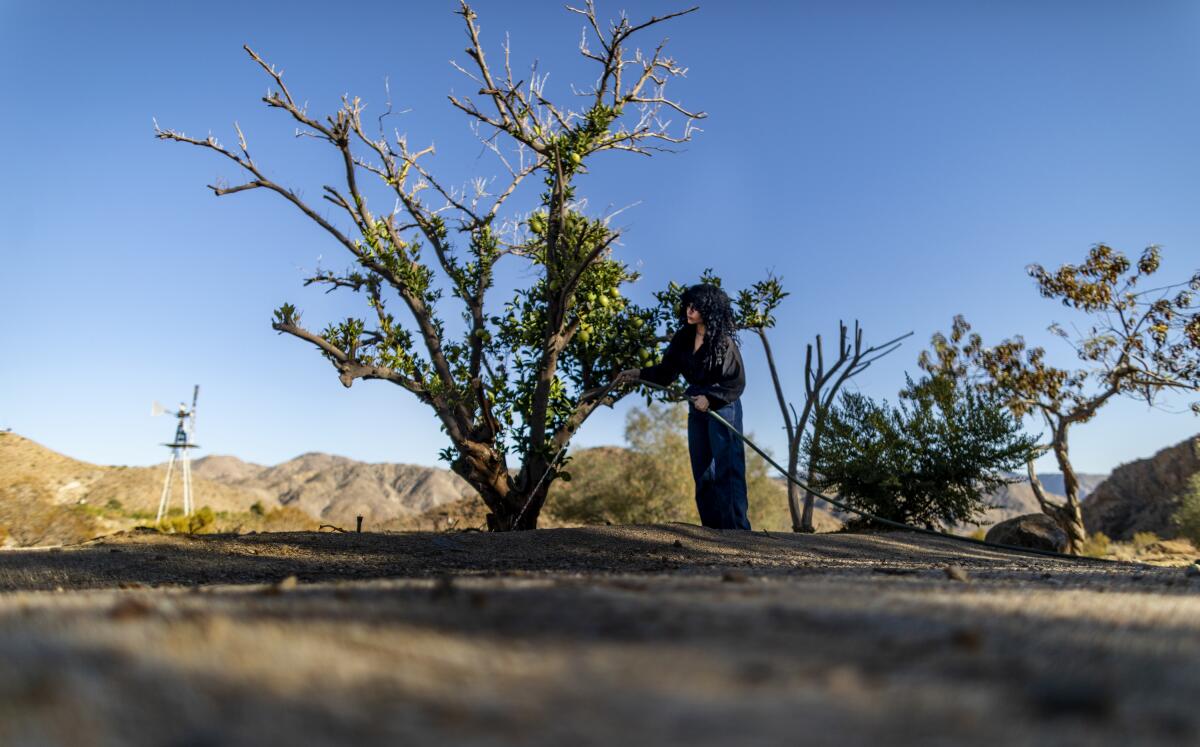
You can even see it in Southern California, where Angelenos are moving east to desert towns like Yucca Valley, Pioneertown and Joshua Tree.
There’s more open space and less sprawl, two things people came to value during the pandemic. Housing is cheaper, and entrepreneurs can afford to take risks, like opening a yoga studio or a saloon.
Moving from the big city to a rural town can take some adjustment — not just for the transplants but also the existing residents, who find themselves contending with the forces of gentrification. Loud parties and quiet Teslas are a lot more common in the desert than they used to be, my colleague Sarah Parvini writes.
Some migrants are still making up their minds about whether to stay long term. But others, like 33-year-old Evanice Holz, are certain they can never go back. Not only does she pay less for an acre of land in the desert than she did for a studio in Silver Lake, but she now also has easy access to hiking trails and a pervasive sense of calm.
Her catering company recently got so busy that she feared she’d have to move back to L.A. When she realized that prospect caused her dread instead of excitement, she knew she had to stay in her new home.
“This whole thing has showed me what really matters,” Holz said.
California’s vaccination progress
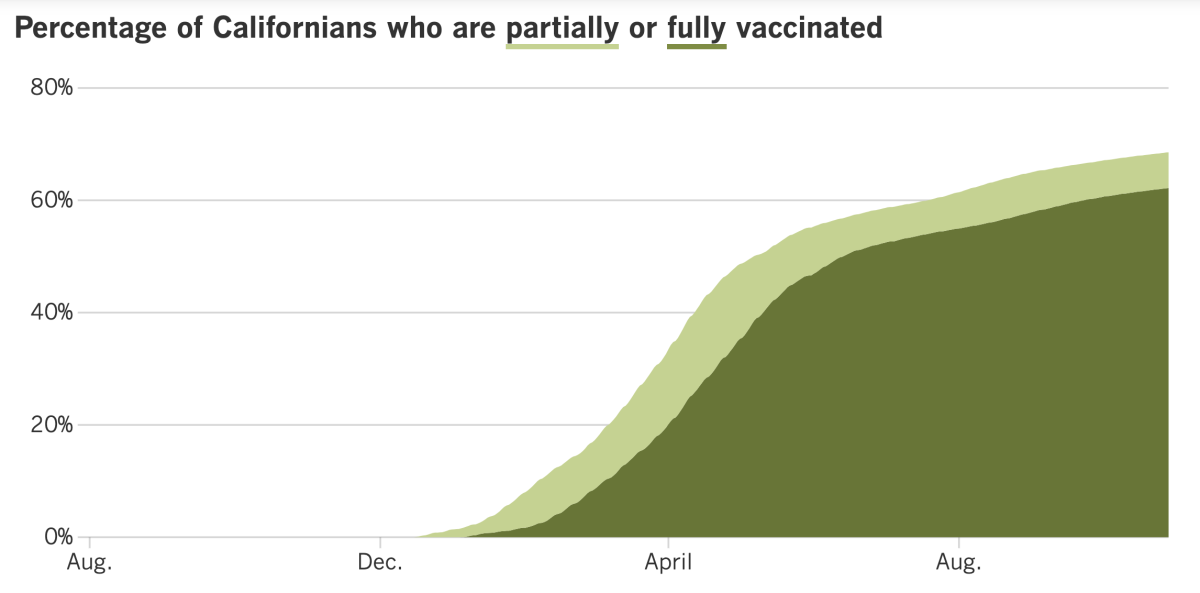
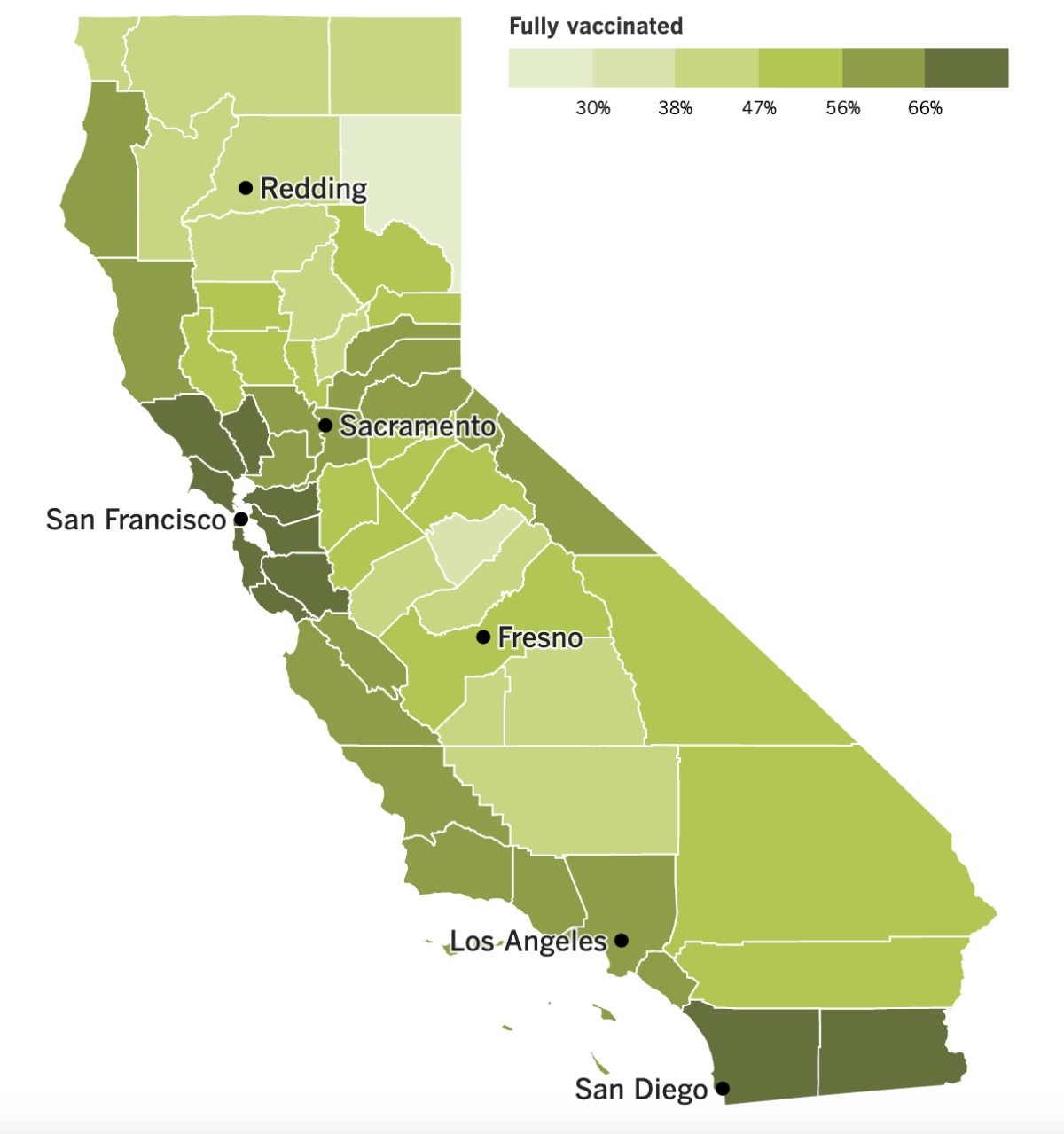
See the latest on California’s vaccination progress with our tracker.
Your support helps us deliver the news that matters most.
In other news ...
We begin with an update on In-N-Out Burger’s efforts to keep serving customers without having to ask them for proof of vaccination. That stance prompted health officials in San Francisco to shut down the chain’s Fisherman’s Wharf location.
Contra Costa County, across the San Francisco Bay, also requires restaurants to check their customers’ vaccination status before allowing them to dine indoors. In-N-Out has responded by suspending indoor dining at its five restaurants there while still offering burgers, fries and shakes through its drive-through windows.
The county’s rule, which went into effect Sept. 22, applies to businesses “where there is an elevated risk of the virus spreading.” Restaurants qualify because people must remove their face masks to eat and drink, the county says.
An In-N-Out in the East Bay city of Pleasant Hill was closed this week by the Contra Costa County Health Department for “not actively demanding vaccine documentation or testing documentation and photo identification” from customers, the company said. It’s now operating takeout service, as are its restaurants in San Ramon, Brentwood, Pittsburg and Pinole.
Now that you have Double-Doubles on your mind, stop for a moment and appreciate the men and women who work in meat processing plants and make those burgers possible. A new congressional report estimates that at least 59,000 meatpacking workers became sick with COVID-19 during the first year of the pandemic.
That figure is nearly three times higher than a tally of infected or exposed workers put forward by the United Food and Commercial Workers Union. It comes from documents provided by JBS, Tyson Foods, Smithfield Foods, Cargill and National Beef.
The report blamed companies for failing to protect workers by giving them personal protective equipment, installing barriers between workstations and implementing other safety measures that were recommended by the CDC. It estimates that 269 workers died of COVID-19 as a result.
“Meatpacking companies prioritized profits and production over worker safety, continuing to employ practices that led to crowded facilities in which the virus spread easily,” the report said.
The companies responded by saying they worked aggressively to meet health and safety standards — and often went beyond them by conducting widespread testing and urging employees to get vaccinated.
Industries across the country are still trying to get back to normal. A report out Thursday from the U.S. Commerce Department said the U.S. economy grew at only a 2% annual rate between July and September. That’s way down from the 6%-plus annual growth rate seen in the first half of the year.
Companies were held back by the Delta variant-fueled rise in COVID-19 cases and by supply shortages that won’t seem to go away. But with cases declining and vaccinations rising, many economists predict the annual growth rate in the fourth quarter will be back in the 6% range, if not better.
Here’s some more good news: An inexpensive antidepressant that’s already FDA-approved was shown to reduce COVID-19 hospitalizations and deaths among adults with health problems that put them at higher risk of serious illness.
The drug, called fluvoxamine, was tested in nearly 1,500 Brazilian COVID-19 patients. Treatment involved two pills a day for 10 days. Those who took it were 32% less likely to be hospitalized or receive extended emergency care and 90% less likely to die. The benefits were so clear that independent safety monitors recommended stopping the trial early.
The findings confirmed the results of smaller trials. But more testing will be needed to determine the ideal dosing, whether the antidepressant would work even better in combination with other treatments, and whether it can help people at lower risk for serious cases of COVID-19.
Whatever the answers, it’s safe to say the drug will be a lot more affordable than other therapies. Fluvoxamine costs $4 per patient, far less than the $2,000 bill for antibody treatments and the $700 price tag of Merck’s promising antiviral pill for COVID-19.
And, finally, Eastern Europe is learning a lesson it could have avoided by observing the U.S.: Vaccine hesitancy fuels spikes in COVID-19.
In Russia, where only about one-third of residents are fully vaccinated, the country recorded 1,163 deaths Friday, the highest single-day toll since the pandemic began. Poland set a record of its own the previous day, with more than 8,000 new infections in a country where nearly half the residents aren’t fully vaccinated.
Ukraine, a country where just 1 in 6 residents are fully vaccinated, is struggling to keep its overtaxed healthcare system from stretching past the breaking point.
“Fake stories have spread widely, making people believe in microchips and genetic mutations,” said Dr. Olha Kobevko, an infectious-disease specialist at a 120-bed hospital in Chernivtsi. “Some Orthodox priests have openly and aggressively urged people not to get vaccinated, and social networks have been filled with the most absurd rumors. Ukrainians have learned to distrust any authorities’ initiatives.”
Dr. Serhiy Shvets, head of the hospital surgical ward in a town of near Odessa, described the consequences more bluntly: “We are on the verge of catastrophe.”
Your questions answered
Today’s question comes from readers who want to know: What’s a safe way to celebrate Halloween?
This question couldn’t be more timely, especially for those — like my colleague Nicholas Goldberg — who don’t know what to make of the fact that some counties have much stricter coronavirus regulations than others, even though the threat is basically the same.
In 2021, trick-or-treating is OK — even Dr. Anthony Fauci said so.
A few weeks ago, we discussed safer ways to go from house to house requesting candy. To recap:
- Get vaccinated if you’re old enough to do so.
- Trick or treat with a smaller group instead of a large crowd.
- If you’re waiting to approach a house, try to practice social distancing.
- Wash or sanitize your hands before digging into any candy.
Adults who are doling out the candy should wear a mask while greeting trick-or-treaters. That way you’ll be protected in case you open your door and find half a dozen kids shouting — or even sneezing — in your direction.
If you’re attending a party, keep in mind that an outdoor gathering is safer than an indoor one. If you’re indoors, you’re better off avoiding crowded rooms and poorly ventilated spaces.
Anyone indoors who is not vaccinated should wear a face mask that covers the nose and mouth. Unless you’re dressing up as a healthcare worker, a mask that’s part of a costume won’t cut it.
Even if you are vaccinated, you should wear a mask indoors if coronavirus transmission rates in your area are high.
We want to hear from you. Email us your coronavirus questions, and we’ll do our best to answer them. Wondering if your question’s already been answered? Check out our archive here.
The pandemic in pictures
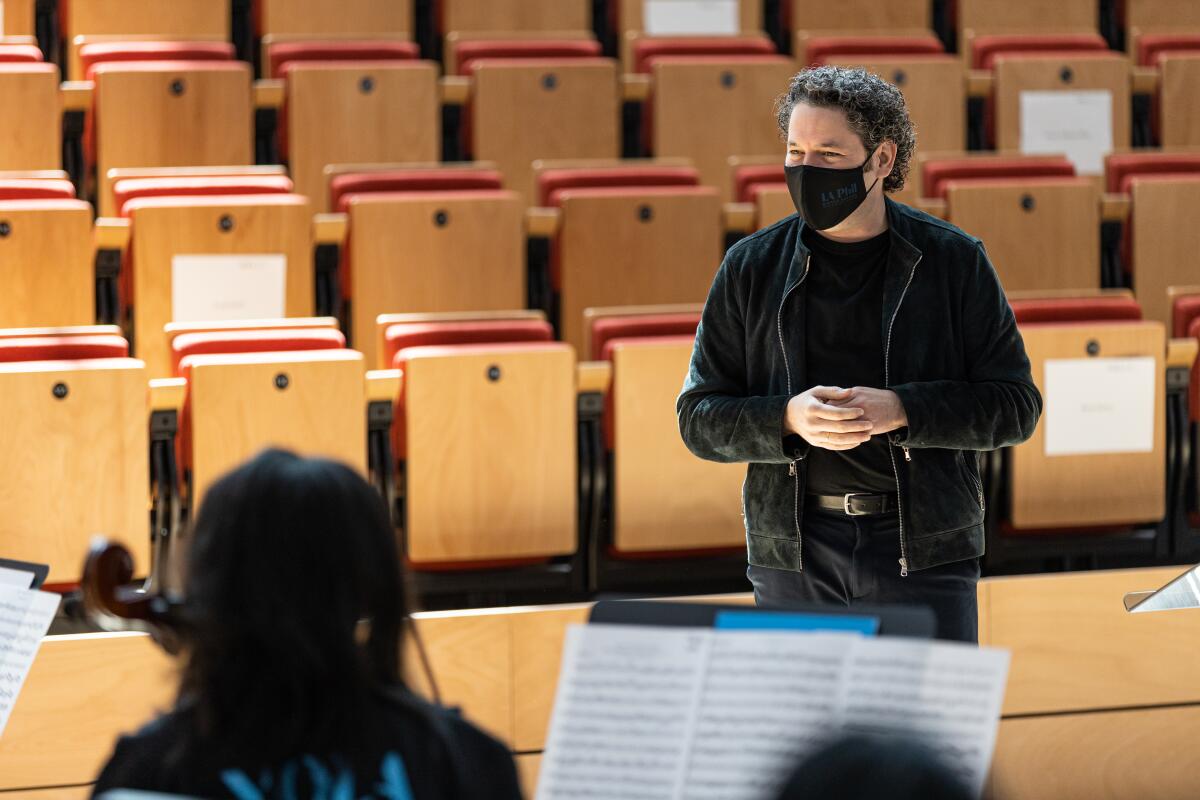
“There is no question that, for all of us, whether or not you lost family or friends, this was a trauma.”
That was said by Gustavo Dudamel, the music and artistic director of the Los Angeles Philharmonic, pictured above. He spoke to my colleague Mark Swed after the classical music critic noticed a change in the orchestra and reached out to Dudamel to find out what was going on.
A lot, it turns out. The pandemic claimed the life of Dudamel’s grandmother, who helped raise him. And without a schedule packed with concerts, the world as he knew it had vanished. In its place is a simpler life of cooking meals for his family, walking his son to school and reading musical scores for fun with a cigar and a glass of Scotch.
“I found a new dimension as a human being — learning, connecting, doing things that I was not before expected to do,” Dudamel said. “It’s a different place that I’m in right now that I feel gives me a completely different sense about how I make music.”
Resources
Need a vaccine? Keep in mind that supplies are limited, and getting one can be a challenge. Sign up for email updates, check your eligibility and, if you’re eligible, make an appointment where you live: City of Los Angeles | Los Angeles County | Kern County | Orange County | Riverside County | San Bernardino County | San Diego County | San Luis Obispo County | Santa Barbara County | Ventura County
Practice social distancing using these tips, and wear a mask or two.
Watch for symptoms such as fever, cough, shortness of breath, chills, shaking with chills, muscle pain, headache, sore throat and loss of taste or smell. Here’s what to look for and when.
Need to get tested? Here’s where you can in L.A. County and around California.
Americans are hurting in many ways. We have advice for helping kids cope, resources for people experiencing domestic abuse and a newsletter to help you make ends meet.
We’ve answered hundreds of readers’ questions. Explore them in our archive here.
For our most up-to-date coverage, visit our homepage and our Health section, get our breaking news alerts, and follow us on Twitter and Instagram.




